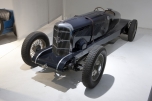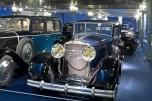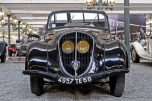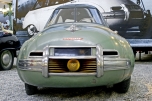Cars from 1920 to 1950 - The golden age of the car
Bugatti Type 40
1929
Code 0707
Body style: van
In 1927, Lieutenant Frédéric Loiseau, serving with the French Army in North Africa, came up with the idea of a super-fast automobile link between French-administered territories, much quicker than the Citroën autochenille half-tracks had managed in 1924.
Frédéric Loiseau managed to convince the Resident General in Tunisia, Mr L. Saint, who was keen on the idea. In Loiseau’s mind, there was no question of which manufacturer should be chosen for these quick, economic and hard-wearing vehicles – Bugatti. When contacted, Bugatti was persuaded of the useful nature of this 15,000 km (9300 mile) journey and sent Loiseau a contract on 25 January 1928, stating the conditions for the supply of various special vehicles.
Type 40 chassis were chosen, the very robust four-cylinder 10 CV model. This was fitted with a solid plywood, “pick-up” style body, with space for cargo and an additional 225-litre fuel tank. Extra mechanical components, such as a hand-operated oil feed pump, a water recovery system and a direct exhaust were also added.
The expedition set off from Place de la Concorde in Paris on 26 January 1929, with the aim of reaching Ivory Coast with five Bugatti 40s, including the model in the museum, the only survivor of the trip. The results were spectacular for 1929! Nearly 15,000 km (9300 miles) were covered in 32 days, driving over dunes, desert sand and grit and barely visible tracks in the beating sun of the Sahara. Frédéric Loiseau’s aim was also to set new speed records, careering off on long lonely drives at the head of the group. He wrote, “My Bugatti is a living being, with keen eyes, a strong, supple back and a wonderful sense of discernment. Man and machine, when they are in harmony, make a perfect team together.”
The trip included a successful trip between Gao, the gateway to the Sahara and Niamey, then capital of Niger, at speeds unheard-of in Africa, with a return journey that included a Bamako-Timbuktu-Gao leg in just two days. The car in the Cité de l’Automobile is the last survivor of this expedition today.
Two key lessons were learned from this successful trip, in addition to the incredible reliability of small Bugattis:
- wheels were clearly better than caterpillar tracks for light and medium-weight vehicles,
- it would be possible to create fast transport routes between African territories even before the development of air routes.



































